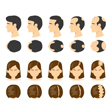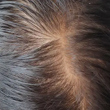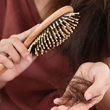How to Use Minoxidil and Dermaroller Together?

Introduction
Minoxidil is a Central Drugs Standard Control Organisation (CDSCO) approved prescribed medication for the treatment of androgenetic alopecia. It is known for arresting hair fall and delaying the onset of baldness in patients with male pattern hair loss or female pattern hair loss (also known as Androgenetic Alopecia or AGA). Dermaroller, on the other hand, is a procedure used mainly for its skin benefits. However, this procedure has also shown benefits like better hair regrowth and reduction in hair loss. (1)
Research also indicates that using these two treatments together shows improved results instead of using just one treatment. But what must you consider before getting these two treatments together? How to use both, and what is the efficacy of using both treatments together? Here is everything you must know about using dermaroller and minoxidil together.
Visit your dermatologist for any hair fall-related complaints to get optimal diagnosis and management plan.
The below mentioned text is for your information only. Minoxidil is a prescription only product and should be used only under dermatologist guidance.
How to Use Minoxidil and Dermaroller Together? 1,2

To use a dermaroller along with minoxidil, it is recommended to first consult a dermatologist for the proper diagnosis of your hair condition and get an opinion from them before beginning the procedure. To use minoxidil and dermaroller together, you can either get it done at a clinic or do it yourself at home.
There are a few points to consider before deciding.
- Dermaroller requires the use of a roller with microneedles; if you are not comfortable with needles, it is better to get it done professionally.
- The dermarollers used in most studies was a 1.5mm device that penetrates deeper into your scalp. This may not be available easily as it is a physician-grade device. Most dermarollers you get will be a 0.25 to 0.5 mm device.
- Dermaroller cannot be shared by 2 or more people. It requires strict aseptic conditions and should not be used for a second time if an aseptic condition is not maintained.
- Most dermrollers are only for 1-time use and needs to be disposed of after use.
To use minoxidil and dermarollers together, it is essential to understand the procedure and follow the correct steps to avoid bruising or irritating your scalp.
- Apply minoxidil on the day of the procedure.
- For sparse hair, use a 1.5mm needle roller device.
- Ensure to use a clean and sanitized roller.
- Apply numbing cream to avoid uncomfortable pricks, but make sure to wash off the cream before using the roller.
- Start by rolling it horizontally first and then from the front going slowly back. Use in longitudinal, vertical, and diagonal directions.
- Use it till comfortable, or you see redness (mild erythema), approximately 5 to 6 times.
- You may feel a mild to medium tingling and pricking sensation in the area of your scalp.
- You may use warm water to rinse the scalp later.
- Clean and sanitize the dermaroller by soaking it in 70 percent isopropyl alcohol for approximately 5 to 10 minutes.
- It is advised not to apply minoxidil for the next 24 hours after the procedure.
Efficacy of Using Minoxidil and Dermaroller Together 2,3

A research study was conducted in 2003 on two groups of AGA patients. One group was given both treatments (5% minoxidil twice daily and weekly dermarollers) and just 5% minoxidil to another group. The group in which both the treatments were given showed superior results of hair regrowth. Statistically, the micro-needling group showed a higher number of patients reporting increased hair growth than the minoxidil group.
This was also affirmed in another International Journal of Research in Medical Sciences study conducted very recently in 2020, where both the patient and the physician evaluated the results. The combined treatment of the 'micro-needling and minoxidil' group showed statistically significant improvement over the 'only minoxidil' group in promoting hair growth in patients with AGA. Dermarollers are a safe and promising treatment option for improving hair regrowth and treating chronic hair loss caused due to AGA.
Conclusion
While minoxidil is used only for AGA, using the two treatments together has shown promising results for regrowth and reduction of hair loss. Studies show that there is an improved intensity of hair growth, and combining minoxidil with dermarollers stimulates this growth.
Before choosing to do both procedures together, we advise you to seek medical advice. After a proper evaluation and diagnosis of your hair loss pattern and condition, dermatologists will prescribe the best treatment option for you. For better results, always follow proper procedures for doing these treatments together and only use sanitized and approved instruments. Before taking the plunge, follow up with your doctor for better care and understand all the risks and benefits of the procedure.
Maintaining a healthy and stress-free lifestyle along with a nutritious diet is also important for optimal hair care. Visit your dermatologist for any hair fall-related complaints to get an optimal diagnosis and management plan.
Disclaimer: Minoxidil is a prescription-only drug. It is to be taken only after a dermatologist’s assessment and prescription. Please consult your dermatologist for further guidance.
Myth Busters HairFall

Androgenetic Alopecia - Everything You Need To Know
Have you been experiencing excessive hair fall over a prolonged period of time? It could be an early sign of androgenetic alopecia. It is a hair loss disorder common in both genders and can lead to progressive thinning and even baldness in some patients if not caught and treated early.

How To Make Hair Grow Faster For Men
A head full of healthy hair is a matter of confidence. Hair has its own mechanism of growing and shedding, and it is when this mechanism is thrown off that growth is hindered. Especially in the case of males, hair growth faces a lot of hiccups that can easily be managed.

Female Pattern Baldness - Causes & Treatments
Have you suddenly noticed an increase in the number of hair strands on your pillow in the morning? Or is your ponytail getting thinner by day? Well, you might be suffering from female pattern baldness. While that does sound scary, identifying it early on is key to treating this condition effectively. So keep reading to know what this is, how you can identify it, and most importantly, what treatments you can avail of to get your beautiful lustrous hair back.

What Are The Reasons For Hairfall?
Almost everyone experiences some amount of hair thinning over the years. Shedding around 50 to 100 single strands of hair per day is considered normal. However, losing more than 150 strands a day, experiencing sudden thinning, or developing circular bald patches on your scalp are reasons for concern. Hair loss occurs when new hair doesn’t grow fast enough to replace the amount of hair you lose daily. Hair can fall due to various reasons, with hereditary hair loss and poor nutrition being the most common hair fall reasons.

Expert Approved Tips For Hair Growth
What can be more debilitating than seeing hundreds of hair strands shedding from your scalp every time you brush your hair? Also, excessive molting occurs during seasonal changes that can be very stressful for you. Although it’s okay to lose between 50-100 strands every day, according to the American Academy of Dermatology, the problem occurs when you start shedding more than normal. But that doesn’t mean you have to feel helpless as there are ways to grow your hair back. Even if you are coping with baldness or alopecia, certain hair growth tips from dermatologists can come to your rescue. Read on to discover how these tips can be your savior when abnormal hair fall problems are in sight.
Trending Videos
+ 3 Sources
'LMRC - GGI-CO-A2-DMA-300001252-300001252-WM-L21-704'
© 2021 Dr. Reddy’s Laboratories Ltd. All rights reserved.